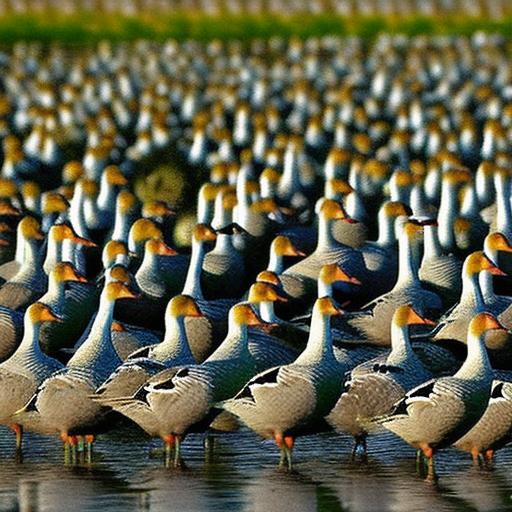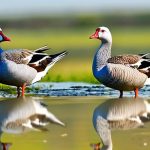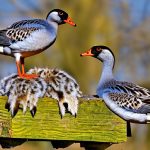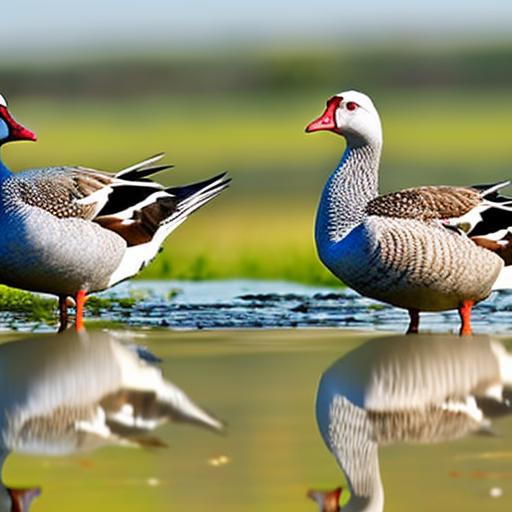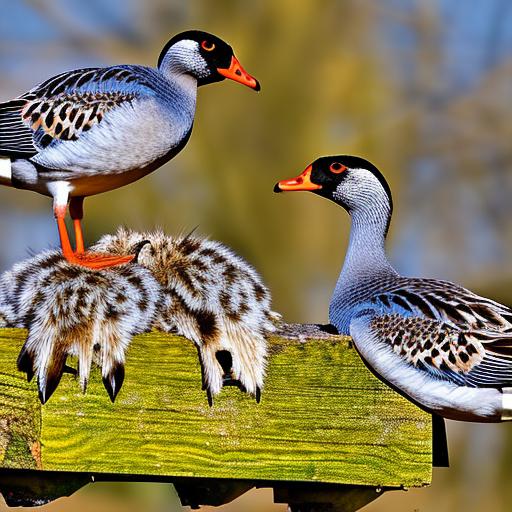Geese are social animals that thrive in a natural environment with plenty of space to roam and graze. When designing a breeding pen for geese, it’s important to understand their specific needs in order to create a healthy and productive environment for them. Geese require ample space to move around and forage for food, as well as access to clean water for drinking and bathing. They also need protection from predators and extreme weather conditions, so the pen should provide shelter and security. Additionally, geese are known for their strong homing instincts, so it’s important to design the pen in a way that prevents them from wandering off or becoming disoriented.
In addition to physical needs, geese also have social and behavioral requirements that should be taken into consideration when designing their breeding pen. Geese are highly social animals that form strong bonds with their flock mates, so the pen should be large enough to accommodate a group of geese and provide opportunities for social interaction. They also have a natural instinct to nest and raise their young, so the pen should include nesting areas and safe spaces for brooding. Understanding and addressing these needs is essential for creating a breeding pen that promotes the health and well-being of the geese, as well as maximizing their productivity.
Designing an Efficient Layout for Your Geese Breeding Pen
When designing a breeding pen for geese, it’s important to create an efficient layout that maximizes space and promotes productivity. The layout should be carefully planned to provide ample room for the geese to move around and forage, while also incorporating nesting areas, feeding and watering stations, and shelter. One effective layout for a geese breeding pen is a circular or oval shape, which allows for easy movement and reduces the risk of crowding or cornering. This layout also provides a central area for feeding and watering, as well as access to nesting areas around the perimeter.
In addition to the overall shape of the pen, it’s important to consider the placement of specific features within the layout. For example, nesting areas should be located in quiet, secluded spots to provide privacy and security for brooding geese. Feeding and watering stations should be easily accessible and strategically placed to prevent overcrowding and competition. Shelter should be provided in multiple locations throughout the pen to ensure that all geese have access to protection from the elements and predators. By carefully planning the layout of the breeding pen, you can create an efficient and productive environment for your geese that meets their physical, social, and behavioral needs.
Utilizing Vertical Space for Maximum Efficiency
In addition to considering the horizontal layout of the breeding pen, it’s important to utilize vertical space to maximize efficiency and productivity. Geese are natural grazers that thrive on a diet of grasses and other vegetation, so providing vertical grazing opportunities can help meet their nutritional needs while also conserving space. One effective way to utilize vertical space in a geese breeding pen is by incorporating raised platforms or shelves for growing grasses and other edible plants. These platforms can be built at varying heights to accommodate different types of vegetation and provide opportunities for geese to graze at different levels.
Another way to utilize vertical space in a geese breeding pen is by incorporating hanging feeders and waterers. By suspending these essential resources from above, you can prevent them from taking up valuable floor space and reduce the risk of contamination from feces or bedding. This also encourages geese to stretch and reach for their food and water, which can promote physical activity and reduce boredom. Additionally, utilizing vertical space can help create a more dynamic and stimulating environment for the geese, which can contribute to their overall health and well-being. By thinking creatively about how to utilize vertical space in the breeding pen, you can create a more efficient and productive environment for your geese.
Implementing Rotational Grazing for Sustainable Resource Management
Rotational grazing is a sustainable resource management strategy that involves dividing grazing areas into smaller paddocks and rotating livestock between them on a regular basis. This practice helps prevent overgrazing, reduce soil erosion, and promote the growth of healthy vegetation. When implementing rotational grazing in a geese breeding pen, it’s important to carefully plan the layout of the paddocks and establish a schedule for rotation. By dividing the grazing area into smaller sections, you can ensure that the geese have access to fresh vegetation while allowing previously grazed areas to recover.
In addition to promoting sustainable resource management, rotational grazing can also benefit the health and productivity of the geese. Fresh vegetation provides essential nutrients and dietary variety, which can contribute to overall health and well-being. Rotating between paddocks can also help reduce the risk of parasite infestations and disease transmission by allowing time for the land to rest and regenerate. By implementing rotational grazing in your geese breeding pen, you can create a more sustainable and productive environment for your flock while promoting the long-term health of the land.
Choosing the Right Feeders and Watering Systems
Choosing the right feeders and watering systems is essential for promoting efficient feeding and hydration in a geese breeding pen. When selecting feeders, it’s important to choose designs that prevent waste and contamination while providing easy access for the geese. For example, trough-style feeders with adjustable heights can accommodate different sizes of geese while reducing spillage and preventing them from walking through their food. Gravity-fed or automatic feeders can also help ensure that the geese have access to fresh food at all times without overeating or wasting.
Similarly, choosing the right watering systems is crucial for promoting hydration and preventing contamination in the breeding pen. Automatic or nipple-style waterers can help ensure that the geese have access to clean water at all times while reducing the risk of contamination from feces or bedding. It’s also important to regularly clean and maintain watering systems to prevent algae growth or bacterial buildup. By choosing the right feeders and watering systems for your geese breeding pen, you can promote efficient feeding and hydration while reducing waste and contamination.
Maximizing Natural Light and Ventilation in the Pen
Maximizing natural light and ventilation in a geese breeding pen is essential for promoting a healthy and comfortable environment for the geese. Natural light provides essential vitamin D and promotes overall well-being, while proper ventilation helps regulate temperature and reduce moisture buildup. When designing the pen, it’s important to consider the placement of windows, doors, and vents to maximize natural light and airflow throughout the space. This can help reduce the risk of respiratory issues, mold growth, and heat stress while promoting a more natural and stimulating environment for the geese.
In addition to promoting physical health, maximizing natural light and ventilation can also benefit the productivity of the geese. Exposure to natural light helps regulate their internal clocks and promotes natural behaviors such as feeding, preening, and nesting. Proper ventilation helps reduce odors and ammonia buildup while promoting air quality and comfort. By maximizing natural light and ventilation in your geese breeding pen, you can create a healthier and more productive environment for your flock.
Implementing Waste Management Strategies for a Clean and Healthy Environment
Implementing waste management strategies is essential for maintaining a clean and healthy environment in a geese breeding pen. Geese produce a significant amount of waste in the form of feces, bedding, and uneaten food, which can quickly accumulate if not properly managed. Regular cleaning and removal of waste is crucial for preventing odors, reducing disease transmission, and promoting overall hygiene in the pen. This can be achieved through regular spot cleaning as well as periodic deep cleaning of the entire space.
In addition to regular cleaning, it’s important to consider waste disposal methods that are environmentally friendly and sustainable. Composting is an effective way to manage organic waste such as feces and bedding, which can then be used as fertilizer for gardens or crops. Separating waste into different categories such as organic, recyclable, and non-recyclable can also help reduce landfill waste and promote sustainability. By implementing waste management strategies in your geese breeding pen, you can create a clean and healthy environment for your flock while minimizing environmental impact.
In conclusion, designing an efficient breeding pen for geese requires careful consideration of their specific needs as well as sustainable resource management practices. By understanding their physical, social, and behavioral requirements, you can create a productive environment that promotes their health and well-being. Utilizing vertical space, implementing rotational grazing, choosing the right feeders and watering systems, maximizing natural light and ventilation, and implementing waste management strategies are all essential components of creating an efficient breeding pen for geese. By incorporating these strategies into your design, you can create a clean, healthy, and sustainable environment that promotes productivity while meeting the needs of your flock.
Meet Walter, the feathered-friend fanatic of Florida! Nestled in the sunshine state, Walter struts through life with his feathered companions, clucking his way to happiness. With a coop that’s fancier than a five-star hotel, he’s the Don Juan of the chicken world. When he’s not teaching his hens to do the cha-cha, you’ll find him in a heated debate with his prized rooster, Sir Clucks-a-Lot. Walter’s poultry passion is no yolk; he’s the sunny-side-up guy you never knew you needed in your flock of friends!

